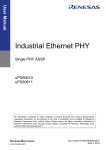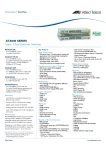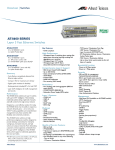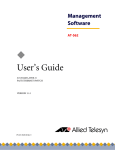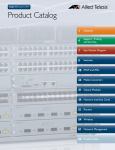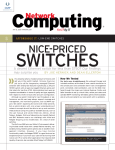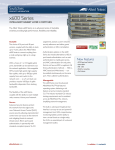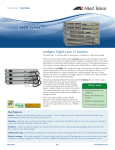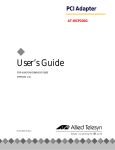Download Allied Telesis AT-8500 Series Installation guide
Transcript
AT-S62 Version 1.4.0 Software Release Notes AT-S62 Version 1.4.0 Management Software for the AT-8500 Series Layer 2+ Switches Software Release Notes Please read this document before you begin to use the management software. Supported Platforms The AT-S62 management software is supported on the following AT-8500 Series switches: AC Models DC Models AT-8516F/SC AT-8516F/SC-80 AT-8524M AT-8524M-80 AT-8524POE - AT-8550GB AT-8550GB-80 AT-8550SP AT-8550SP-80 This release supports the following redundant power supplies: AT-RPS3004: Supported on the AT-8516F/SC, AT-8524M, AT-8550GB and AT-8550SP. AT-RPS3104: Supported on the AT-8524POE. The DC models do not support a redundant power supply. This release supports the following expansion modules for the AT-8516F/SC, AT-8524M, and AT-8524POE switches: AT-A45/SC: One 100Base-FX fiber optic port with a duplex SC connector AT-A45/MT: One 100Base-FX fiber optic port with an MT-RJ connector AT-A46: One 10/100/1000Base-T twisted pair port with an RJ-45 connector AT-A47: One GBIC slot PN: 613-000490 Rev. A 1 Allied Telesyn, Inc. AT-S62 Version 1.4.0 Software Release Notes Product Documentation For hardware installation instructions, refer to the following guide: AT-8500 Series Layer 2+ Fast Ethernet Switches Installation Guide (PN 613-50484-00) For management instructions, refer to the following guides: AT-S62 Menus Interface User’s Guide (PN 613-000124) AT-S62 Web Browser Interface User’s Guide (PN 613-000127) AT-S62 Command Line Interface User’s Guide (PN 613-50486-00) All documents are available from the Allied Telesyn web site at www.alliedtelesyn.com. Caution The software described in the documentation contains certain cryptographic functionality and its export is restricted by U.S. law. As of this writing, it has been submitted for review as a “retail encryption item” in accordance with the Export Administration Regulations, 15 C.F.R. Part 730-772, promulgated by the U.S. Department of Commerce, and conditionally may be exported in accordance with the pertinent terms of License Exception ENC (described in 15 C.F.R. Part 740.17). In no case may it be exported to Cuba, Iran, Iraq, Libya, North Korea, Sudan, or Syria. If you wish to transfer this software outside the United States or Canada, please contact your local Allied Telesyn sales representative for current information on this product’s export status. Note The Public Key Infrastructure (PKI), Secure Sockets Layer (SSL), and Secure Shell (SSH) encryption features are included as standard components of the AT-S62 version 1.4.0 management software. In previous versions, these features had to be ordered separately. Note An AT-8500 Series switch running AT-S62 version 1.2.1 or earlier must be upgraded to version 1.3.0 before you can upgrade it to version 1.4.0. You cannot directly upgrade a switch from version 1.2.1 or earlier to version 1.4.0. PN: 613-000490 Rev. A 2 Allied Telesyn, Inc. AT-S62 Version 1.4.0 Software Release Notes AT-S62 Version 1.4.0 New Features Fan control. This new feature for the AT-8524POE switch automatically adjusts the speed of the unit’s cooling fans based on the ambient temperature of the room or wiring closet where the unit is installed and the load requirements of the PoE devices connected to the ports on the device. This feature is adjusted from the System Configuration menu in the menus interface and the SET SYSTEM FANCONTROL command in the command line interface. This feature is not supported in the web browser interface. The default setting for this feature is disabled. Quality of Service. The following new parameters have been added to Quality of Service flow groups, traffic classes, and policies: - ToS parameter for replacing the Type of Service field of IPv4 packets. - Move ToS to Priority parameter for replacing the value in the 802.1p priority field with the value in the ToS priority field in IPv4 packets. - Move Priority to ToS parameter for replacing the value in the ToS priority field with the 802.1p priority field in IPv4 packets. - Send to Mirror Port parameter for copying traffic to a destination mirror port. (QoS policies only.) The new parameters are adjustable from the menus and command line interfaces, but not the web browser interface. 802.1x port-based network access control. The following new features have been added to authenticator ports: - MAC address-based authentication as an alternative to 802.1x username and password authentication. - Supplicant mode for controlling the number of supplicants who can log on to an authenticator port. - Guest VLAN parameter that permits an authenticator port to be a member of a designated VLAN when no supplicant is logged on. - VLAN assignment and secure VLAN parameters that allow for dynamic VLAN assignments from a RADIUS authentication server for supplicant accounts. The new parameters are configured from the Configure Authenticator Port Access Parameters menu in the menus interface and the SET PORTACCESS|PORTAUTH PORT ROLE=AUTHENTICATOR command in the command line interface. They can also be configured from the Authenticator Parameters page in the web browser interface. Unknown multicast packet filtering feature. This feature discards all unknown ingress multicast packets on a port. It can improve switch performance in situations where a multicast stream arrives on a port of a switch where there are no host nodes. The feature is set through the Port Configuration menu in the menus interface and the SET SWITCH PORT command in the command line interface. This feature can also be set through the Port Configuration window in the web browser interface. (The menu location and command for this feature were stated incorrectly in the software release notes for AT-S62 Version 1.3.0 Patch 01.) SNMP community strings. The maximum length of an SNMP community string has been increased to 32 characters from 14 characters. (Backward compatibility is provided in the PN: 613-000490 Rev. A 3 Allied Telesyn, Inc. AT-S62 Version 1.4.0 Software Release Notes event the management software on a switch is rolled back to an earlier version of the AT-S62 software. In such an event, only the first 14 characters of an extended SNMP community string are displayed.) Resolved Issues AT-8550GB and AT-8550SP switches and BPDUs. The AT-8550GB and AT-8550SP switches did not transmit BPDUs when STP, RSTP, or MSTP was activated. This problem is resolved. SNMP community strings and special characters. The management software now displays an error message if you include a special character in an SNMP community string. The only permitted characters are alphanumeric characters (A to Z, a to z, and 0 to 9). SNMP AtiStkSwMacAddr2VlanEntry MIB object. This object displayed only the MAC addresses learned by the ports that were members of the management VLAN. The object now displays all learned MAC addresses. (3144) System Date and Time. The individual fields for manually entering the system’s time and date in the web browser interface were not labelled. This problem is resolved. (3002) Denial of Service Defense. Specifying a mirror port for the IP options defense mechanism periodically caused the switch to enter a fault state where it rejected commands to enable or disable the defense mechanism. This problem is resolved. The manner in which the destination port of the mirrored traffic is specified has been changed. To mirror the traffic of a defense mechanism that supports traffic mirroring, you now must activate the port mirroring feature and specify the destination port from that feature, rather than from within a denial of service defense mechanism. (3004) System temperature threshold. A change to the temperature threshold was not retained after a system reset or power cycle. The command for setting the threshold has been removed. This parameter can no longer be adjusted from its default setting of 60° Celsius. The switch sends an SNMP trap if the threshold is exceeded. (2941) AT-A47 module. The management software stopped responding to commands when instructed to display the operating settings of an AT-A47 module. This issue is resolved. (3316) SNMP. The management software slowed or stopped responding after some SNMP functions, such as snmpwalk. This issue is resolved. (3646) Telnet management session. Repeatedly logging in from a Telnet management session and displaying system files caused the management software to stop saving configuration changes to the active boot configuration file. It also stopped displaying the system files. This issue is resolved. (3683) ARP request. The switch stopped forwarding packets and responding to management commands if it received an ARP request with a source MAC address identical to its own address. This issue is resolved. (3721) IP address. The switch stopped forwarding packets and responding to management commands if it detected a node whose IP address was the same as its own address. This issue is resolved. (3764) Port status. The management software stopped responding to commands if a port was continuously polled for its status over an extended period of time. This issue is resolved. (3802) PN: 613-000490 Rev. A 4 Allied Telesyn, Inc. AT-S62 Version 1.4.0 Software Release Notes Known Issues Combo ports on the AT-8550GB and AT-8550SP switches. The redundancy function of the combo ports on RoHS-compliant versions of the AT-8550GB and AT-8550SP switches may not function as described in the AT-8500 Installation Guide under some conditions. When the combo ports are connected to other combo ports on a similar switch, the redundancy function performs as described in the documentation. Priority is given to a link on a fiber optic port on an SFP or GBIC module over a link on a redundant twisted pair port (ports 49R and 50R). However, when a combo twisted pair port is connected to a regular port (i.e., not a combo port) on another device, priority is given to that port rather than the fiber optic port. In the latter scenario, a fiber optic port on an SFP or GBIC module will only establish a link to a remote node when its paired twisted pair port is not connected or has not established a link. (4056) atiStkSwSysAction MIB object. Starting with version 1.4.0, changes made with SNMP to the operating parameters of a switch are no longer automatically saved to the active boot configuration file on the device. Rather, they must be saved with the saveConfig option in the atiStkSwSysAction MIB object. However, the saveConfig option is nonfunctional in this release and selecting it may cause the SNMP client on the unit to stop responding to SNMP commands. To avoid this issue, use one of the other management interfaces (i.e., menus, command line, or web browser) to save your changes to the switch’s configuration file when you are finished managing a unit with SNMP. The other options of the atiStkSwSysAction MIB object, reset and defaultConfig, are functional. (4067) 802.1x authenticator port parameters. Changing all of the parameters of an 802.1x authenticator port from the default values may cause the switch to insert an invalid command in the active boot configuration file. The MAXREQ parameter is assigned an invalid value. (3955) Operational Notes AT-S62 version 1.2.1 or earlier upgrade. Note the following if you are upgrading a switch from version 1.2.1 or earlier to version 1.4.0: - You cannot upgrade directly from version 1.2.1 or earlier to version 1.4.0. You must first upgrade the switch to version 1.3.0 and then to version 1.4.0. - If the DHCP/BOOTP client software is active and the unit is obtaining its IP configuration from a BOOTP server, you must activate the BOOTP client software on the unit after the upgrade is complete. This does not apply if the switch is using a DHCP server. Gigabit Ethernet fiber optic ports. Disconnecting the Rx fiber strand from an optional Gigabit Ethernet fiber optic port without also simultaneously disconnecting the Tx strand while there is traffic on the cable may cause the port to fail. Reactivating the port may require removing and reinserting the GBIC module or rebooting the system. To avoid this problem, always disconnect both Rx and Tx strands simultaneously when disconnecting a fiber optic cable from a Gigabit Ethernet fiber optic port. (2088) Power over Ethernet. A powered device connected to an AT-8524POE switch can draw 10% above the specified maximum amount of power on a port, up to the maximum 15.4W. For example, a setting of 10W for a port’s maximum power allows a powered device to draw up to 11W. (2250) Quality of Service. The ingress and egress ports of a Quality of Service policy on an AT-8550GB or AT-8550SP switch must be from either of the following two groups. A QoS policy cannot contain ports from both groups: (2346) - Group 1: Ports 1 to 24 and 49 PN: 613-000490 Rev. A 5 Allied Telesyn, Inc. AT-S62 Version 1.4.0 Software Release Notes - Group 2: Ports 25 to 48 and 50 Quality of Service. The bandwidth meters on an AT-8500 Series switch are applied to port blocks with each block consisting of eight ports (e.g., 1 to 8, 9 to 16, etc.) Bandwidth allocation for the packet flow of a defined traffic class is equally divided among the ports of a block. (3858) Configuration files. A boot configuration file with a large number of commands can take up to two minutes for the switch to load. (1093) Configuration files. Do not use Microsoft’s NotePad to edit or view a configuration file. Some versions of NotePad may add formatting codes to the file. Use WordPad instead, or some other text editor that will not add formatting codes to the file. When saving the file, do not change the “.cfg” extension in the filename and be sure to save the file without formatting codes. Configuration files. The AT-S62 Management Software Menus Interface User’s Guide incorrectly states that the name of the default boot configuration file is default.cfg. The correct name is boot.cfg. Enhanced stacking. The enhanced stacking feature of the AT-S62 management software uses the IP address 172.16.16.16. Do not assign this address to any device on a subnet when using the enhanced stacking feature. Enhanced stacking. An AT-8500 Series switch functioning as the master switch of an enhanced stack must be running AT-S62 V1.2.1 or later to recognize an AT-8524POE switch in a stack. The management software on a master AT-8500 Series switch running an earlier version should be upgraded if a stack contains an AT-8524POE switch. Login password. The maximum length of a login password is 16 alphanumeric characters for manager accounts created through the RADIUS and TACACS+ authentication protocols and passwords for supplicant accounts for 802.1x port-based access control. Manager and supplicant accounts with passwords exceeding the limit are denied access to the switch. Port settings. The parameter settings of a port are not returned to the default values when a port is removed from a port trunk. The port retains the settings it had as a member of the trunk. (2144) Port settings. The PORT parameter featured in many of the AT-S62 command line commands has an ALL option for specifying all ports on a switch. However, for AT-8516F/SC and AT-8524M switches, the option only works when both expansion slots contain expansion modules. Otherwise, the switch displays an error message. To specify all ports on a switch where one or both expansion slots are empty, enter the ports as a range. For example, for an AT-8524M switch you would enter PORT=1-24. (2026) Port settings. Flow control and back pressure on the AT-8550GB and AT-8550SP switches are operational among devices connected to the following port groups, but are not operational between these two groups: (1361) - Group 1: Ports 1 to 24 and 49 - Group 2: Ports 25 to 48 and 50 TFTP. The management software can take up to four minutes to time out a failed TFTP download, during which time you will be unable to manage the switch. (1171) SNMP MIBs. The following MIB objects are not supported: AtiStkSwPortMirroringConfigInfo SourceModuleId, AtiStkSwPortMirroringConfigInfo - SourcePortId, and AtiStkSwPortMirroringConfigInfo - DestinationModuleId. (1829) PN: 613-000490 Rev. A 6 Allied Telesyn, Inc. AT-S62 Version 1.4.0 Software Release Notes MAC addresses. You must move the cursor manually from field to field when entering a static MAC address in the MAC Address field of the Add MAC Address page of the web browser interface. The cursor does not move automatically. (1699, 2123) AT-A45 module. The activity LED on the AT-A45 module only illuminates for egress traffic. This does not affect the operation of the module. (1775) AT-A46 module. The duplex mode LED on the AT-A46 module may remain on when the module is installed but before a cable is connected to the port or after the link to the end node is lost. This does not affect the operation of the module. (1048) TACACS+. The TACACS+ client software on the switch supports Password Protection Protocol (PAP), but not Challenge Handshake Authentication Protocol (CHAP) or AppleTalk Remote Access Protocol (ARAP). (1078) Statistics. Tagged frames larger than 1522 bytes are counted in the “Jabber” statistics counter. This applies to the base ports on the switch and the AT-A45 module port, but not to other expansion module ports. (1705) Port trunks. The following load distribution methods for static and LACP port trunks are nonfunctional: source IP address, destination IP address, and source and destination IP addresses. If you select one of these methods for a trunk, the switch instead uses source MAC address, destination MAC address, or source and destination MAC addresses, respectively. VLANs. The AT-8550GB and AT-8550SP switches can take up to 20 seconds to complete the VLAN configuration process when the VLAN mode is changed from user-configured VLANs to one of the multiple VLAN modes, or vice versa. During this period you are not permitted to manage the switch. (2708) IGMP. The switch, when configured for IGMP, will not register a tagged IGMP query in the IGMP routers list if ingress filtering is disabled and the VID in the packet does not match the VID of the ingress port. (1493) SNTP. The SNTP client software on the switch sends a Transmit Time Stamp with a value NULL when synchronizing with a Network Time Protocol server. This does not affect the operation of the SNTP client software. (1676) PN: 613-000490 Rev. A 7 Allied Telesyn, Inc. AT-S62 Version 1.4.0 Software Release Notes Feature History Version 1.3.0 LACP (IEEE 802.3ad) port trunks Networking stack Syslog protocol IGMPv3 support Password reset Redundant power supply information Version 1.2.1 Auto-Negotiation (IEEE 803.3u-compliant) for speed and duplex mode Auto and manual MDI/MDI-X Flow control (IEEE 802.3x and 802.3z-compliant) Head of line blocking prevention Multicast, broadcast and unknown unicast rate control Port mirroring Port trunking (IEEE 802.3ad) (static link aggregation, non LACP) MAC address port security Port statistics (RMON) Static MAC addresses Spanning Tree Protocol (IEEE Std 802.1D) Rapid Spanning Tree Protocol (IEEE Std 802.1w) Multiple Spanning Tree Protocol (IEEE Std 802.1s) Virtual LANs (IEEE 802.1Q) Ingress filtering GARP VLAN Registration Protocol (GVRP)-based dynamic VLANs Secure Sockets Layer (SSL) Protocol (not included in AT-S62 NE) Secure Shell (SSH) Protocol (not included in AT-S62 NE) Public Key Infrastructure (PKI) Certificates (not included in AT-S62 NE) Management VLAN Multiple VLAN modes Event log Enhanced stacking IGMP Snooping (RFC 2236) Classifiers Access Control Lists PN: 613-000490 Rev. A 8 Allied Telesyn, Inc. AT-S62 Version 1.4.0 Software Release Notes Quality of Service Class of Service (IEEE 802.1p-compliant) Strict priority and weighted round robin priority scheduling File system SNMPv1, SNMPv2c and SNMPv3 management Text-based configuration file Denial of service prevention 802.1x Port-based Access Control Power over Ethernet (IEEE 802.3af) (AT-8524POE switch only) RADIUS accounting Password protected management access Management access control list RADIUS and TACACS+ authentication protocols Xmodem and TFTP downloads and uploads Static and dynamic (BOOTP and DHCP clients) IP configuration Static and dynamic (SNTP client) system time configuration Bad cable detection Fan and temperature diagnostics PN: 613-000490 Rev. A 9 Allied Telesyn, Inc. AT-S62 Version 1.4.0 Software Release Notes Contacting Allied Telesyn This section provides Allied Telesyn contact information for technical support as well as sales or corporate information. Online Support You can request technical support online by accessing the Allied Telesyn Knowledge Base from the following web site: www.alliedtelesyn.com/kb. You can use the Knowledge Base to submit questions to our technical support staff and review answers to previously asked questions. Email and Telephone Support For Technical Support via email or telephone, refer to the Support & Services section of the Allied Telesyn web site: http://www.alliedtelesyn.com. For Sales or Corporate Information You can contact Allied Telesyn for sales or corporate information at our web site: http:// www.alliedtelesyn.com. To find the contact information for your country, select Contact Us then select Worldwide Contacts. Obtaining Management Software Updates New releases of management software for our managed products can be downloaded from the following Internet sites: Allied Telesyn web site: http://www.alliedtelesyn.com Allied Telesyn FTP server: ftp://ftp.alliedtelesyn.com The FTP client software is required to download new software from the Allied Telesyn FTP server from your workstation’s command prompt. You must also log in to the server. Enter ‘anonymous’ as the user name and your email address for the password. PN: 613-000490 Rev. A 10 Allied Telesyn, Inc.













